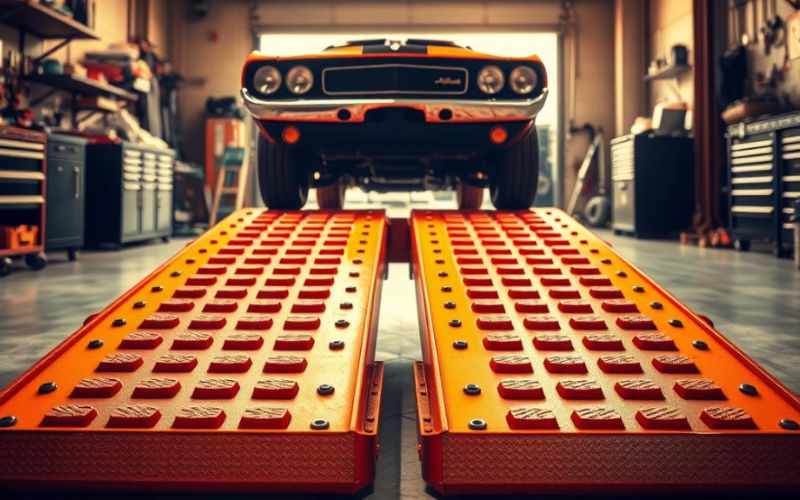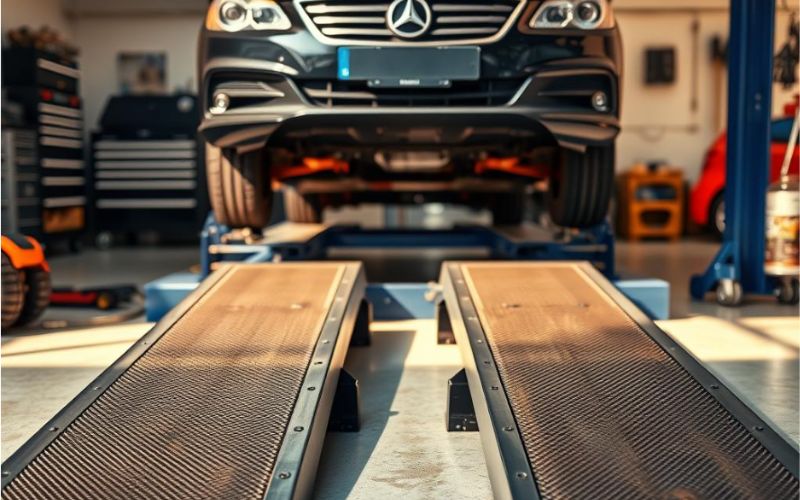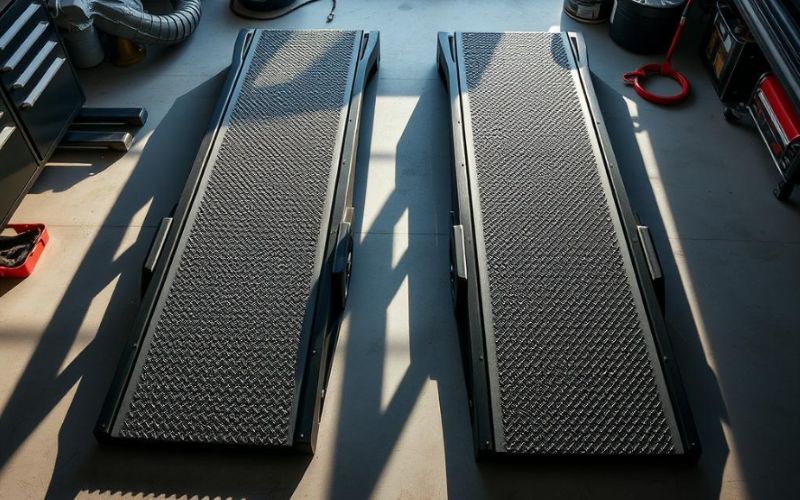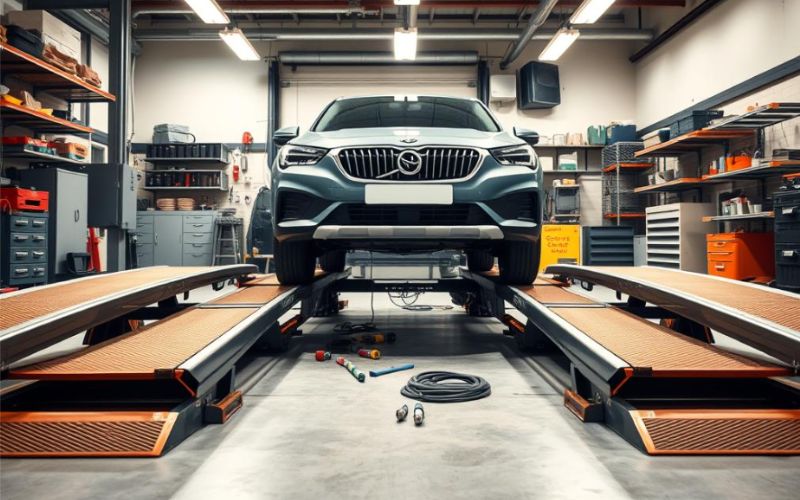Doing your own oil changes can save money and feel good. But, you need the right tools to do it safely and well. A good set of car ramps is key.
Car ramps make oil changes easier by giving you access to your car’s underside. This makes the job safer and less likely to cause injury.
Getting quality tools for DIY car repairs is important. This includes oil change accessories. It makes the job easier and less scary.
Topic Summary
- Why Car Ramps Are Essential For DIY Maintenance
- Best Car Ramps For Oil Change Projects
- Key Features to Look For in Quality Maintenance Ramps
- Proper Usage and Safety Tips For Car Ramps
- Conclusion
- FAQs on Reliable Car Ramps For DIY Oil Changes
- What Are The Best Car Ramps For Oil Change Projects?
- How Do I Choose The Right Car Ramps For My Vehicle?
- What Safety Features Should I Look For in Car Ramps?
- Can I Use Car Ramps For Vehicles Other Than Cars, Like Trucks or SUVs?
- How Do I Properly Position My Vehicle on Car Ramps?
- What Are Some Common Mistakes to Avoid When Using Car Ramps?
- Are There Any Specific Car Ramps Recommended For Low-Clearance Vehicles?
- Can Car Ramps Be Used For Other Maintenance Tasks Beside Oil Changes?
Why Car Ramps Are Essential For DIY Maintenance
DIY car maintenance needs the right tools, and car ramps are at the top. They make it safe and easy to get under your car. This is great for oil changes, brake pad swaps, and checks.
Safety Benefits of Using Proper Equipment
Car ramps make DIY car work safer. They’re better than jack stands because they’re stable and easy to use. You can drive onto the ramp, keeping your car stable.
Car ramps offer many safety perks. They give a solid base, cut down on jack stand risks, and help you work safely without back strain.
| Safety Feature | Car Ramps | Jack Stands |
| Stability | High | Moderate |
| Ease of Use | Easy | Moderate to Difficult |
| Risk of Accident | Low | Moderate |
Advantages Over Jack Stands
Car ramps beat jack stands for DIY jobs. They’re easy to use. Just drive onto the ramp and you’re set.
Car ramps also make working easier. You don’t have to get into awkward spots like with jack stands. This makes maintenance simpler.

Cost Savings of Home Oil Changes
Doing oil changes at home saves money. You skip the mechanic’s labor fees. Plus, car ramps are a one-time buy that lasts for many jobs.
For the best savings, pick durable car ramps that fit your car. Good equipment saves you from costly mistakes or accidents later.
Best Car Ramps For Oil Change Projects
The right car ramps can make oil changes easier. They keep you safe and make the job quicker.
Plastic vs Metal Ramps: Material Comparison
Choosing between plastic and metal ramps is key. Each has its own good and bad points.
Plastic ramps are lighter and cheaper. They also won’t scratch your tires. But, they might not last as long as metal ramps.
Durability Factors
- Plastic ramps can crack under heavy weight or extreme temperatures.
- Metal ramps are stronger and can handle heavier cars.
Weight Considerations
The ramp’s weight is important. Lighter ramps are easier to move and store. But, they might not be as stable as heavier ones.
“For heavy-duty applications, metal ramps are often the better choice due to their superior strength and durability.”
John Doe, Automotive Expert
Low-Profile Ramps For Sports Cars
Sports cars need special ramps because of their low ground clearance. These ramps are gentle on the car’s underside but give enough room for maintenance.

Heavy-Duty Ramps For Trucks and SUVs
Trucks and SUVs need strong ramps to hold their weight. These ramps are made to handle heavy loads and offer a stable place for upkeep.
- Find ramps that can hold your vehicle’s weight.
- Look for ramps with anti-slip surfaces and tire stops for safety.
Key Features to Look For in Quality Maintenance Ramps
Quality car ramps are key for safe vehicle maintenance. Look for certain features when picking ramps for DIY work. Make sure they fit your vehicle and maintenance needs.
Weight Capacity and Vehicle Compatibility
Choosing the right car ramps starts with their weight capacity. They must support your vehicle’s weight safely. Also, check if the ramps fit your vehicle’s make and model. Consider tire size and ground clearance too.

Safety Features: Anti-Slip Surface and Tire Stops
Safety is top when picking car ramps. An anti-slip surface keeps your vehicle steady. Tire stops or chocks also keep your vehicle in place, making it stable.
Incline Angle and Clearance Height
The ramps’ incline angle matters for easy driving onto them. The clearance height lets you work under your vehicle. Choose ramps with a gentle incline for low-clearance vehicles and steeper for high-clearance ones.
Focus on weight capacity, safety, and incline angle to pick the best ramps. This ensures your safety and the success of your DIY projects.
Proper Usage and Safety Tips For Car Ramps
To use your diy car repair tools safely, like oil change accessories and ramps, is important. Car ramps help you get under your car for repairs. But, you must use them safely and follow best practices.
Correct Positioning and Approach
Putting your car on ramps right is key for safety and good use. You need to think about the surface and how to line up your car.
Surface Requirements
The place for your car ramps should be solid, flat, and clear of dirt or things in the way. A strong, slippery-free surface keeps the ramps and your car stable.
Alignment Techniques
To line up your car with the ramps, drive slowly and carefully. Make sure your car’s wheels are right in the middle of the ramps. Stop when your car is fully on the ramps.
| Alignment Technique | Description | Benefit |
| Centered Wheels | Ensure vehicle wheels are centered on the ramps. | Prevents slipping off the ramps. |
| Slow Approach | Drive slowly onto the ramps. | Reduces the risk of accidents. |
| Full Support | Ensure the vehicle is fully supported by the ramps. | Enhances safety during maintenance. |
Securing Your Vehicle on Ramps
After you put your car on the ramps, make sure it doesn’t move. Use the parking brake and wheel chocks for extra safety.

Common Mistakes to Avoid
Don’t make mistakes like ignoring the ramps’ weight limit, not checking if the surface is level, or not securing your car. Knowing these mistakes can make using car ramps safer.
- Ignoring weight capacity
- Using ramps on uneven surfaces
- Failing to secure the vehicle
Conclusion
Choosing the right car maintenance ramps is key for a good DIY oil change. The best ramps make it safe and easy to get under your car.
Look at the ramps’ weight capacity, material, and safety features. Things like anti-slip surfaces and tire stops are important. The right ramps make oil changes smoother and safer.
Good car ramps save you money in the long run and help keep your car running well. With the right tools, you can do oil changes and more easily. This keeps your car in top shape.
FAQs on Reliable Car Ramps For DIY Oil Changes
What Are The Best Car Ramps For Oil Change Projects?
The best car ramps for oil changes depend on your vehicle’s type and weight. Heavy-duty ramps made of metal or quality plastic are good for most cars. Brands like Rhino, Turin, and Performance Tool are reliable choices.
How Do I Choose The Right Car Ramps For My Vehicle?
Choose car ramps based on weight capacity, vehicle type, and maintenance needs. Make sure they fit your car’s make and model and can handle its weight. Also, consider the ramps’ material and how long they last.
What Safety Features Should I Look For in Car Ramps?
Look for car ramps with anti-slip surfaces, tire stops, and strong construction. These features prevent accidents and keep your vehicle stable. Some ramps also have rubber coatings and weighted bases for extra safety.
Can I Use Car Ramps For Vehicles Other Than Cars, Like Trucks or SUVs?
Yes, there are ramps for trucks and SUVs. These are heavier-duty and can handle more weight. Make sure they match your vehicle’s size and weight.
How Do I Properly Position My Vehicle on Car Ramps?
Place your vehicle on a level, firm surface. Align it with the ramps and drive on slowly, keeping it centered. Use tire stops or chocks and engage the parking brake.
What Are Some Common Mistakes to Avoid When Using Car Ramps?
Avoid mistakes like not checking weight capacity, ignoring surface needs, and not securing the vehicle. Also, be careful with damaged or worn-out ramps, as they can be unsafe.
Are There Any Specific Car Ramps Recommended For Low-Clearance Vehicles?
Yes, for low-clearance vehicles like sports cars, use low-profile ramps. They are less steep and have a lower height. Look for ramps with adjustable incline or those made for low-clearance vehicles.
Can Car Ramps Be Used For Other Maintenance Tasks Beside Oil Changes?
Yes, car ramps are good for tasks like brake pad replacement, suspension work, and inspections. They offer a safe and easy way to access your vehicle’s underside, making them versatile for DIY maintenance.

